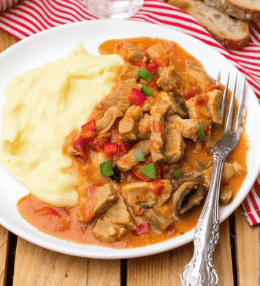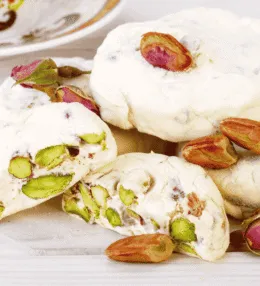
- View
Table of Contents
ToggleYorkshire Pudding is a baked batter dish that has become a familiar feature of British Sunday roasts. Crisp on the outside and soft in the centre, it is both a comfort food and a point of pride for families who keep the tradition alive.
It is not a pudding in the sweet sense, but a savoury staple that holds its place on the table alongside roast beef and gravy. Its character lies in the way simple ingredients, when baked properly, rise into something airy yet hearty.
What makes Yorkshire Pudding appealing is its ability to absorb flavour. Whether filled with thick gravy or paired with meat juices, it becomes more than a side. It turns into an essential part of the meal, binding everything together.
Want to dive deeper into British Cuisine? Don’t miss our post on Traditional British Foods to Try
What Is Yorkshire Pudding?
Yorkshire Pudding is a batter made from flour, eggs, and milk, poured into hot fat and baked until it rises and turns golden. It is traditionally served in large portions or as smaller puddings baked in individual tins.
The trick lies in achieving the right rise. A very hot oven and hot fat cause the batter to puff up quickly, leaving the pudding with a hollow centre and crisp edges. Timing and heat are everything in its preparation.
Yorkshire Pudding is versatile. It can be served as part of a roast, used to hold gravy, or even enjoyed as a starter with onion sauce. The recipe is simple, but the results depend on careful handling and proper heat.
Ingredients and Taste
The batter begins with plain flour, eggs, and milk, sometimes with a pinch of salt. Beef dripping is the traditional fat, though modern cooks may use oil. The fat must be heated until smoking before the batter is poured in.
Once baked, the pudding develops a crisp exterior while the inside stays soft and slightly chewy. The flavour is mild but savoury, making it a perfect partner for gravies, roasted meats, or even vegetables cooked in rich sauces.
Yorkshire Pudding is not strongly seasoned on its own. Instead, it acts as a backdrop, soaking up juices and enhancing whatever it is served with. Its appeal comes from its texture and its role as a carrier of flavour.
A Taste of History
The dish has roots in northern England, particularly Yorkshire, where cooks sought ways to make meat roasts stretch further. Batter was poured into pans beneath roasting joints so that it caught the dripping fat and baked into a pudding.
This approach meant families could enjoy a filling starter before the meat was served, making the meal more economical. It reflected a resourceful style of cooking where nothing from the roast was wasted.
Yorkshire Pudding grew in popularity during the eighteenth century when recipes began to appear in printed cookbooks. Over time it shifted from a thrifty first course to an expected companion of roast beef.
Today, it remains a central part of Sunday roast traditions across Britain. Whether baked large and sliced at the table or served as individual portions, it continues to bring substance and comfort to family meals.
How to Make Yorkshire Pudding
Yorkshire Pudding is a treasured British classic, traditionally served with roast beef and rich gravy. Expect airy, golden puddings with crisp edges and soft centres. The key is fiercely hot fat and a well-rested batter. See the recipe card at the bottom for printable directions
Ingredients
- 140g plain flour
- 4 large eggs
- 200ml whole milk
- ½ tsp salt
- 4 tbsp beef dripping (or vegetable oil if unavailable)
Cooking Instructions
Step 1: Preheat the oven
To begin, preheat your oven to 220°C (fan 200°C, gas mark 7). Place a 12-hole muffin tin inside the oven with a little beef dripping in each cup. Heat until the fat is smoking hot. Transition to making the batter.
Step 2: Make the batter base
Take a large bowl and sift in the flour with the salt. Crack the eggs into the centre and whisk gradually, drawing in the flour until a thick paste forms. Proceed to adding the milk.
Step 3: Incorporate the milk
Slowly pour in the milk while whisking continuously to form a smooth, lump free batter. The consistency should be similar to double cream. Move to resting the batter.
Step 4: Rest the batter
Allow the batter to rest at room temperature for at least 30 minutes. Resting improves structure and rise. In the meantime, check your oven and ensure the fat remains hot.
Step 5: Prepare the tin
Once the batter is rested, carefully remove the tin from the oven. The fat should be shimmering and almost smoking. Transition quickly to filling the cups.
Step 6: Fill the cups
Pour the batter evenly into the hot tins, filling each cup to around half. Work swiftly to avoid losing heat. Immediately return the tin to the oven.
Step 7: Bake the puddings
Bake without opening the oven door for 20–25 minutes until the puddings are puffed, golden, and crisp. Avoid peeking, as this will cause them to collapse. Prepare for serving.
Final Step: Serve hot
Remove the puddings and serve immediately alongside roast beef, gravy, or roasted meats. Presentation tip: stack the puddings in a serving dish to showcase their height and airy structure.
Variations and Substitutions
- Beef dripping substitute: Use goose fat, duck fat, or vegetable oil if dripping is unavailable.
- Milk substitute: Semi-skimmed milk works, though whole milk provides richer flavour.
- Large format: For a traditional large Yorkshire pudding, use a baking dish instead of a muffin tin and adjust cooking time to 30–35 minutes.
Cooking Tips for Perfect Yorkshire Pudding
- Always preheat the fat until smoking before adding batter.
- Rest the batter for at least 30 minutes for best lift.
- Do not open the oven door during baking.
- Serve straight away, as they deflate slightly if left too long.

Yorkshire Pudding (Baked Batter)
Ingredients
- 140 g plain flour
- 4 large eggs
- 200 ml whole milk
- ½ tsp salt
- 4 tbsp beef dripping or vegetable oil if unavailable
Instructions
- To begin, preheat your oven to 220°C (fan 200°C, gas mark 7). Place a 12-hole muffin tin inside the oven with a little beef dripping in each cup. Heat until the fat is smoking hot. Transition to making the batter.
- Take a large bowl and sift in the flour with the salt. Crack the eggs into the centre and whisk gradually, drawing in the flour until a thick paste forms. Proceed to adding the milk.
- Slowly pour in the milk while whisking continuously to form a smooth, lump free batter. The consistency should be similar to double cream. Move to resting the batter.
- Allow the batter to rest at room temperature for at least 30 minutes. Resting improves structure and rise. In the meantime, check your oven and ensure the fat remains hot.
- Once the batter is rested, carefully remove the tin from the oven. The fat should be shimmering and almost smoking. Transition quickly to filling the cups.
- Pour the batter evenly into the hot tins, filling each cup to around half. Work swiftly to avoid losing heat. Immediately return the tin to the oven.
- Bake without opening the oven door for 20–25 minutes until the puddings are puffed, golden, and crisp. Avoid peeking, as this will cause them to collapse. Prepare for serving.
- Remove the puddings and serve immediately alongside roast beef, gravy, or roasted meats. Presentation tip: stack the puddings in a serving dish to showcase their height and airy structure.
Nutrition
You May Also Like







Leave a Review